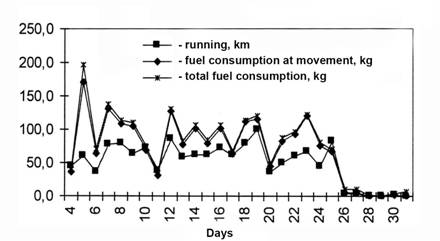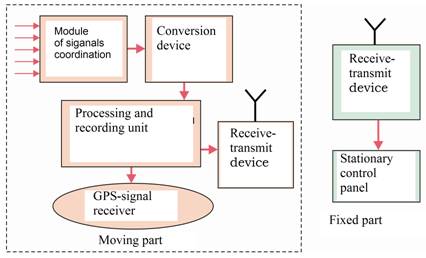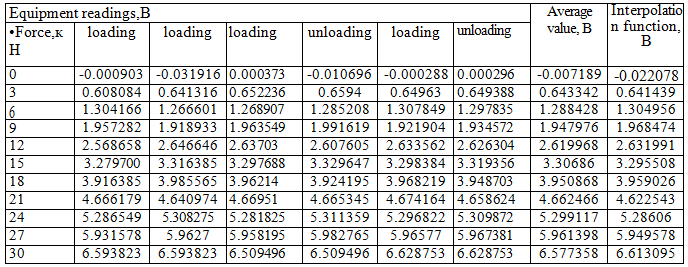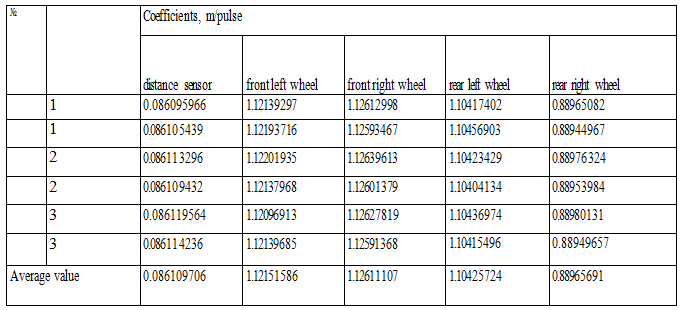DEVELOPMENT OF AGRICULTURAL MACHINERY TESTING TECHNOLOGIES
Буклагин Д.С.
Доктор технических наук, «Российский научно-исследовательский институт информации и технико-экономических исследований по инженерно-техническому обеспечению агропромышленного комплекса» (ФГБНУ «Росинформагротех»)
РАЗВИТИЕ ТЕХНОЛОГИЙ ПОЛЕВОГО ЭКСПЕРИМЕНТА ПРИ ИСПЫТАНИЯХ СЕЛЬСКОХОЗЯЙСТВЕННОЙ ТЕХНИКИ
Аннотация
В статье показано важное значение испытаний сельскохозяйственной техники в решении задач модернизации сельскохозяйственного производства. Отмечены недостатки существующей методологии полевых испытаний машин в значительной степени, обусловленных отсутствием отработанной технологии испытаний, основанной на современных достижениях измерительной техники и использования навигационных систем Глонасс/GPS. На основе анализа использования навигационных систем в сельскохозяйственной производстве, достижений в научной сфере, ставится задача развития методов и технических средств испытаний с использованием технологии ГЛОНАСС/GPS и сотовой связи, позволяющих повысить достоверность результатов в условиях реальной эксплуатации.
Ключевые слова: сельскохозяйственная техника, испытания, навигационная система, сотовая связь, методы измерений, достоверность результатов, развитие, модернизация, реальные условия эксплуатации.
Buklagin D.S.
PhD in Engineering, Federal State Budgetary Scientific Institution “Russian Research Institute of Information and Technical and Economic Studies on Engineering and Technical Provision of Agro-Industrial Complex” (FGBNU ”Rosinformagrotekh”)
DEVELOPMENT OF AGRICULTURAL MACHINERY TESTING TECHNOLOGIES
Abstract
The article demonstrates the importance of agricultural machinery testing in solving the agricultural industry modernization task. The drawbacks of the existing methodology of machines field tests to a large extent conditioned by the lack of the tried-and-true test technology based on the latest achievements of the measuring equipment and use of GLONASS/GPS navigation systems and on-line communication are mentioned. Based on the analysis of the use of navigation systems in agricultural industry and scientific achievements, the development of tests methods and techniques is challenged using GLONASS/GPS and cellular telecommunication, which allow increasing results reliability under the actual operating conditions.
Keywords: agricultural machinery, tests navigation system, cellular communications, measurement methods, results reliability, development, modernization, actual operating conditions.
To increase the competitiveness of the Russian agricultural products, it is required to reduce costs, improve product quality and labor productivity. It can only be achieved by using a new high-tech equipment or technology with significantly improved consumer performances. This means that agricultural producers have to operate such processing machines which excel analogs or other machines available at farms. Replacement of the overage machine with the new one, typically, does not produce the desired effect, i.e. each new machine shall be purchased to replace obsolete models and include such innovation measures which will be effective for agricultural producers, increase the competitiveness of their products.
Answers to these questions are closely related to the development of machines tests system of the Russian Ministry of Agriculture, which is to determine the functional characteristics (consumer properties) and the efficiency of agricultural machinery and equipments and to meet the challenges of the technical and technological modernization of agricultural industry.
At present the test system includes 10 machine testing stations (MTS) testing machinery and technologies, including foreign ones, in the main soil-climatic zones of Russia and render substantial assistance to the agro-industrial complex experts in selection of future machines and technologies by publication of test results in various editions and the Internet, participation in training and retraining of personnel, arrangement of exhibition activity in regions.
The test technologies are regulated with about 7500 codes and specifications, including about 300 developed in the MTS system. They are provided with measurement instrumentation, including mobile data-processing systems for indicators definition as per the assessment types: agronomic, energy, working conditions, operation-and-technological and economic, evaluation of other design parameters of machines.
About 15% of the tests total volume is covered by the foreign equipment tests, which data are used for assessment of the quality of the process performed by multipurpose agricultural machines and justification of economic efficiency resulted from their operation in Russia.
One of the main objectives of the tests is to increase the reliability of the results obtained. Meanwhile, the currently used technologies of field tests do not often provide the required accuracy of equipment assessment, not always take into account the actual operation conditions are determined. For example, the high degree accuracy indicators of machine reliability can be determined only during the long-term tests under common operation of several machines that seldom are implemented in practice.
The existing test methodology has the following drawbacks:
- time ofan experimentis limited tolaboratory experiments;
- test resultsby assessment types aredo not often coincidewith timeand test conditions;
- there are restrictionson the number ofsimultaneouslytested machines;
- insufficient amount of running hours;
- virtuallynocomparative tests.
For example, the quality of the machines operation is estimated based on the results of laboratory and field tests on short plots (30-100 m), typically with homogeneous background. Indicators of energy assessment, including fuel consumption, will be determined under the results of at least four measurements obtained within at least 20 sec. [1]. This may 1.5-2.0 times overestimate the figures obtained under actual operation conditions, reduce the accuracy of the economic indicators determination and assessment of tested equipment perfection degree.
Currently the system of machine testing undergoes technical modernization, is provided with modern laboratory, instrumentation and test equipment, reference standards of modern tractors and agricultural machinery, information and measurement complexes for the wireless information transmission, data collection and processing on the basis of GLONASS and GPS, wireless Internet to use them for testing (validation) sites.
This paper considers the trends of improving the existing and developing new methods of testing of agricultural machinery and machine agricultural technologies based on use of the latest achievements in the field of measuring techniques, telemetry and navigation systems.
According to the analysis by the present time the significant steps have been taken towards creation of global space systems of localization and advanced telecommunications systems. Although these systems are quite costly, but due to their capabilities and scales they are dynamically implemented in agricultural industry.
The Global Positioning Systems are widely used in motor vehicles for optimal routing and monitoring of queuing, in technologies of precise agriculture.
According to expert estimation, today the area of crops cultivated with precision farming technologies is about 1 million hectares. For example, in Belarus the scientists are already working on development of elements of intelligent farming system. This system involves the use of unmanned harvesters and tractors in agriculture. The system includes remote controlled agricultural machinery. The movement of agricultural machinery will be controlled by the satellite on which base the global management system will be established [2].
Use of telemetry systems is one of the promising trends of development, especially in terms of control of transport systems. GLONASS/GPS-receivers are already installed on agricultural machinery. Navigators record different indicators: transport and agricultural machinery movement, fuel consumption and speed, then send the collected information via high-speed data transmission network to a single server for costs processing and optimization. [3].
Equipment of agricultural machinery with navigation systems allows for real-time:
monitoring of agricultural machinery location, direction and speed;
monitoring of technological speed maintenance of the equipment during field work;
collection of information to issue the field certificate, determine the exact boundaries of the fields, measure the area of farmland, crop yields;
identification of equipment downtime and failures;
monitoring of equipment movement e (quality of border cultivation during seeding and treatment with herbicides);
study of physiological properties of an operator for the performances of human-machine systems.
Outfitting agribusiness with GLONASS/GPS systems witnesses that the domestic agriculture is becoming hi tech economy sector. Therefore, the test methods of mechanical means should be based on advanced development and wide use of modern measuring equipment in testing technologies.
Today it is hard to imagine that modern science-intensive and innovative machines and technologies can be evaluated with the test methods developed over half a century ago.
Thus, future models of testing technologies should be based on the technologies which allow testing under actual operating conditions and arranging comparative testing machines in a new light.
The application of modern measuring systems allows for much more objective information describing a test object and equipment operating conditions, carrying out the timing, recording all the necessary values, including equipment failures, responding in due time to changes in the technical conditions and rules of the machines operation, use of specialized programs to determine the main indicators of equipment under test.
The test methodology based on navigation systems can increase the number of simultaneously tested objects, including in several regions, at different machine testing stations, that increases the results objectiveness of agricultural machinery testing, benefits the information processing and receipt of various reports on test results. Considering that in the course of operation the agricultural machinery is subjected to a large number of factors, the numerical values of indicators are random variables, so improvement of the test reliability requires an increase in operating time, continuous measurements and system analysis of machines designation indexes, that brings the tests to the routing operation conditions, increases the accuracy of their determination and results of the comparison with an analogue. Such test methodology can be provided by measuring systems with GLONASS/GPS.
Foreign practice confirms that the upgrading of machines complexity, their outfitting with electronic systems increasingly orient tests on the accuracy improvement of field conditions simulation, the use of the latest test methods to generate comparable data and objective information obtaining for making investment decisions. New test methods cover the systems of GPS, ISOagriNET (standard of data transfer systems compliance), ISOBUS (standard for data exchange) which allow combining the measurement data obtaining and its mathematical processing directly in the experiment using the specialized computing devices [4].
The GPS-components are also applied in foreign measuring systems for testing vehicles for noise, fuel consumption and other indicators. Such systems are primarily focused on reducing the time spent for equipment installation and maximum reliability of measurements [5, 6].
To collect information for operational and technological assessment is quite labor intensive process, therefore the investigators constantly attempt to automate this process using different systems: APИCA, ИП-238, ИП-261, ИП-264 and others. However, the problem of observations results processing has not been completely solved yet.
Although a number of sensors and transducers, which can be used in the system of machine testing have already been developed [7], to measure all parameters provided by regulatory guidance documents the focused efforts will be applied to establish a system of primary transducers which ensure the required measurements and transmission via the GLONASS/GPS information on current (shift) fuel consumption, performance, yield, error-free running time and other indicators. The analysis shows that the use of navigation systems is beginning to be applied for the purposes of machines testing.
Currently, several developments are known which relate to the use of GLONASS/GPS in the field of agricultural machinery testing and aimed at improving the accuracy of measurements. The experts of Tekhnokom LLC developed “AvtoGRAF” - a system of satellite monitoring based on the modern technologies in the field of satellite navigation and channels of data communication and processing [8]. The system allows on-line monitoring of vehicle location, its movement direction, mileage and the volume of fuel consumed (Fig. 1).
Fig. 1 - Functional Diagram of “AvtoGRAF” System
The GLONASS module with an external active antenna receives coded signals from the satellites of the GLONASS system and defines the geographic coordinates of the receiver location, as well as the exact time, speed and direction of movement. The received data are output from the module to the CPU, the core of the “AvtoGRAF” controller connecting all the components of the system and ensuring their interaction according to its program. In the developed system the assessment of the dynamic object condition is solved with the neural network technology taking in account the mechanism of information receiving, storing and processing.
A device receiving signals of navigation satellites is installed on the vehicle board, and the appropriate program – in the control room. The device on the vehicle board collects information on its location with a given period or by analyzing the nature of the vehicle motion travel route records, saving considerable amount of data transmitted. The device can store the route within several years.
When testing technologies and machines, the timing is quite labor-intensive activity. A particular problem is to obtain data on traffic speeds and motion path of process machines, as well as data on product transportation distances and speeds of vehicles. With the development of information communication technology the process information during testing of machines for fodder production can be collected using developed GPS positioning systems [9].
The system is based on the fact that a computer program based on the Pocket PC ASUS My Pal A 632 communicates with four stationary satellites and accurately records a position of the machine at the site. The computer communicates with the satellite after a certain period of time, each time records its location, that allows to obtain the following parameters of machines:
- average speed;
- travel time;
- travel distance;
- time and stop period.
The advantage of this system is that the timing process can be performed by one person, including a driver of the machine.
The system has the integrated adder unit, which measures the entire travel of the equipment for a given time period. The program has a large number of different options, including visualization of process machine motion pattern.
The system operation was tested in CJSC Shushary during silage and hay gathering. The forage harvesters and vehicles operation was recorded. For the data analysis and processing the results were transferred from the handheld to a desktop computer, where they were processed using MS Exel.
Based on the experience of GPS + ASUS My Pal A 632 application for collecting the information on process and industrial machines operation it can be concluded that the developed system allows to determine the basic parameters of the tested equipment with significant reduction of timing labor costs.
As an example, fig. 2 presents the information on the daily run and fuel consumption of the МТЗ-1221 tractor obtained by using GLONASS / GPS satellite navigation system and sensors installed on the tractor [14].
Fig. 2 - Daily run and fuel consumption of the МТЗ tractor
Table 1 shows the overall performance of the tractor running and fuel consumption.
Table 1 - indicators of running and fuel consumption per month (total)
The developed system can be used to determine such parameters as engine load, idle time, a period of performing technological operations and other indicators assessed when testing agricultural machinery.
When determining the parameters of comparative tests of new agricultural equipment it is necessary to determine the fuel consumption, labor intensity and time required for maintenance, performance and other indicators. For these purposes the ИИС-76 information-measuring system was developed, the main practical purpose of which is automatic on-line receipt of accurate data on energy and operational and process performances of the mobile agricultural equipment [11]. ИИС-76 includes (Fig. 3): devices of conversion, receive-transmit, processing and registration, a global localization system receiver. Matching module and conversion device ensure operation of primary transducers for speed measurement (the GPS and GLONASS receiver) of draft force, moment on PTO shaft, rotation of the driving wheels and PTO shaft, engine oil temperature, coolant and fuel. ИИС-76 operation principle: signals received from the primary transducers are preprocessed (multiplication, noise filtering, etc.) and digitized in the conversion device. In RBM is an accumulation of data, display them on the screen and the calculation of the required parameters. The processing and recording unit accumulates data, displays them on the screen and calculates the required parameters. Then the receiving transmit device provides the reception and transmission of digital information via the mobile communication channel (GPS-modem) to the stationary control path within a radius of 60 km/h from the tested object. Any mobile IBM can be used as the processing and recording unit. The main requirement is the availability of the serial port operating under USB or RS232 protocol, and the control program. A personal computer running the operating system Windows is the best for the tests purpose. Based on the test results the system provides high accuracy of indicators recording by eliminating the factors of the subjective nature.
Fig. 3 - ИИС-76 System Structure
The performed tests showed that the system is operable both in laboratory and field conditions. Data transfer between movable and stationary parts of the system was carried out without failure. The connection between GSМ-modems was stable at a distance of 60 km.
In laboratory tests, calibration and determination of calibration errors of the САЗ tensometer link was carried out at loading up to 30 kN. The load generated during graduation of the tensometer link was determined by the ДОСМ 3-3 standard dynamometer [12]. Measurement and calculation results are shown in Table 2.
Table 2 - calibration results of the САЗ tensometer link
The results of performed calculations of parameters according to GOST R 52777-2007 were the following:
standard deviation from calibration characteristic, kN δ =2,53 *10-2
basic absolute error of calibration, kN α=9,049 *10
basic given error of calibration, % λ=1,37
Nominal static coefficient of transform function k= 4.54, kN/B.
Calibration of distance and wheel revolutions sensors was carried out in the area of 100 m long at three-speed modes. The results of the calibration are shown in Table 3.
Table 3 - results of calibration of distance and wheel revolutions sensors
Calculations and measurements made in accordance with GOST 8.207-76 showed that the relative error of distance and wheel revolutions measurements does not exceed 0.1%. During tests it was noted the ease to mount the system on the tested machine, obtaining measurement results in real time mode and the ability to process and store large information content.
An analysis of global trends shows that modern information technologies allow developing universal means of measuring operation parameters machine and tractor units and perform their continuous monitoring at significant distance from the tested object [13].
Practical implementation of continuous monitoring allows the collection of machine and tractor units (assembly) operation parameters to evaluate its technical condition during operation. The schematic of similar system is shown in Fig. 4. Simultaneously several complexes of information collection can be applied which data are forwarded to the server. Internet is used as the communication channel.
Fig.4 - Schematic of Remote Control Complex of machine and tractor units (assembly) operation parameters:
1 – object of study with primary converters; 2 – GPRS-modem; 3 – GSM network; 4 – Internet; 5 – server; 6 – remote control mobile station
The server is connected to the Internet via the dedicated channel, which allows online control over stations collecting the MTA operation parameters, which locate at the site of study.
To reduce the traffic between the work station and the server the optimal time and synchronization frequency settings shall be determined, and a part of calculation shall be transferred to the station. The server receives partially processed and packed data. The server program collects data from several work stations, additionally processes, archives and provides remote clients with the access to this information in a form convenient for them. Such complex of the remote control can be used wherever a network GSM is located.
The analysis shows that the use of GSM-modules allows the development of systems for obtaining information on current, shift and seasonal irrigation flow, performance, operating hours of running modes and failures of equipment, i.e. indicators, which are determined during the machines tests. The method of units yield rating on the basis of satellite monitoring is under developing. The method is based on the certification of fields, equipment of machines and tractors assembly with additional sensors which allow recording the exact times of farm machinery transfer in different positions. It is indicatively that, for these purposes the on-board electronics installed by the manufacturer of power unit can be used [14].
The use of such systems allows considering the operators physiological fatigue, its impact on performance and more reliably and comprehensively evaluate the performance of complex human-machine systems under actual operation conditions.
The wide computerization of modern agricultural technology contributes to the development of the field testing technology of agricultural machinery. Thus a system of TELEMATICS machine remote control with a special module with SIM-card continuously reads data on the machine location, engine parameters, production rate, fuel consumption, crop yield. The system memory stores up to 160 parameters which every 5 min. are forwarded via the mobile Internet to the server of data processing [15].
The methods of remote land sensing are successfully developed to determine the area and assess the condition of agricultural land, crop forecasting, relevance and quality of agricultural activities and other trends which can be used to improve the reliability of machines and technologies test results.
Conclusions
In conclusion, it should be noted that the efforts of the machines testing system, research companies are focused on the development of a test methodology which enables high reliability in determining the effectiveness of process and design solutions which significantly improve or create new consumer properties of machines, provide higher efficiency compared to analogues. Such test results should be the basis of technical and technological modernization of machine and tractor fleet of the country. One of such trends allowing to improve the accuracy of the tests results, bring them closer to the conditions of actual operation is the use of modern navigation systems and mobile communication for receipt, transmission and processing of experimental data under the special algorithms which allows to provide the agricultural producers with justified recommendations on technical and technological modernization of agricultural industry. For this it is required to develop an integrated system of program, organizational and technical, and methodological measures aimed at the development of methodological and technical basis ensuring the development of modern technologies for agricultural machinery testing.
References
- GOST R 52777-2007. Agricultural Machinery. Methods of Energy Evaluation.
- Agricultural Machinery. – 2012. – No. 10. – Pp. 59.
- Agricultural Machinery of Agricultural Company Shatskaya is equipped with GLONASS/GPS-receiver with built-in Megaphone SIM-cards. - Agricultural Machinery. – 2012. – No. 6. – Pp. 27.
- Testing of Agricultural Machinery – the main task of DLG testing. Profi International. Tractors and Farm Machinery. – 2011. – No 11. – Рp. 28-29.
- www.telemetrie-word, TMS. Telemetrie-Messtechnik Schnorrenberg. Pp. 1-64.
- Big brother is watching//Topagrar. 2012. No. 2 P. 132-136.
- N.A. Petrishchev. The use of telemetry information on-board systems for monitoring of the technical conditions of tractors and automotive agricultural machines // Agricultural Machinery: Maintenance and Repair. – 2012. – No. 11. – Pp. 38-45.
- I. Bolodurina, V. Reshetnikov. Improving the accuracy of ground-space monitoring in the GLONASS system / Information Resources of Russia. – 2012. – No. 5. – Pp. 27-29.
- A.M. Valge, E.V. Тimofeev. Experience of using the GPS global positioning system for timing of the technical means during laying-in of fodder / In the book: Technology and Techniques of Mechanized Production of Crops and Livestock Products: Collection of scientific papers / GNU SZNIIMESKH of the Russian Agricultural Academy. – Rev. 81. - Saint-Petersburg, 2009. – Pp. 61-66.
- 10.ValgeM.,PapushinE.A.Evaluation ofperformance of machine and tractorunitsaccording to theGLONASS/ GPS satellite navigation system.Energy supplyand efficiencyin agriculture.Proceedings ofthe 9th InternationalScientific Conference(21-22 May 2014,Moscow,GNU VIESKH). Part 5:Information and Communication Technologiesand Nanotechnologies. Moscow:GNUVIESKH. Pp.132-136.
- V.E. Tarkivsky Express assessment of agricultural machines resource saving indicators // Machinery and equipment for rural area. – 2011. – No. 6. – Pp. 39-41.
- 12. Carrying out research and development of a system for express-evaluation of high-tech agricultural machinery complexes by resource-saving criteria: research report / Novokubansk branch of FGNU "Rosinformagrotekh"; chief scientist: Tarkivsky E.; researchers: Fedorenko V.F., Tabashnikov A.T., Buklagin D.S. [et al.] 2009. 119 pp.
- A.P. Inshakov, O.F. Kornaukhov, A.F. Filin The method of establishing the measuring-computing complex for MTA testing // Tractors and farm machinery. – 2012. – No 10. – Pp. 14-15.
- P.A. Vashlanov, D.A. Petrovsky Platform for performing and analyzing ONLINE field tests // Agrarian Mechaniс. – 2013.–No. 9.– Pp. 10–11, 27.
- Electronic solutions for CLAAS forage harvesters // Machinery and equipment for rural area. – 2013. – No. 4. – Pp. 14-16.







